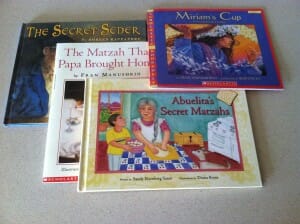 Every year, Jews around the world celebrate Passover by participating in one or two Seders, eating special foods, and following a variety of rituals. Children’s authors have captured the key ingredients of these traditional practices in picture books. These books help to educate children who are unfamiliar with the holiday and simultaneously reinforce concepts for children who practice the traditions.
Every year, Jews around the world celebrate Passover by participating in one or two Seders, eating special foods, and following a variety of rituals. Children’s authors have captured the key ingredients of these traditional practices in picture books. These books help to educate children who are unfamiliar with the holiday and simultaneously reinforce concepts for children who practice the traditions.
In this blog, I will briefly review 4 picture books that focus on different rituals associated with Passover. I also provide links to more Passover picture books.
3 Passover Picture Books Highlighting the Seder
1. Miriam’s Cup: A Passover Story (Scholastic Inc., 1998) By Fran Manushkin Illustrated by Bob Dacey
In Miriam’s Cup, Fran Manushkin uses the backdrop of preparing for a Passover Seder to introduce the biblical story of Miriam. Before opening a Passover gift, a young girl listens to her mother retell the story of Moses’ sister, Miriam. The text of the story appears on side panels that are adjacent to stunning illustrations created by Bob Dacey. Bob was awarded a Silver Medal by the Society of Illustrators for this book.
Readers will learn about Miriam’s faith, courage, and the power of her songs. Her brave actions assured the survival of the Jewish people. Today Jewish families during Passover honor Miriam by adding a cup filled with water to their Seder table. The mother in this story gives her daughter a crystal goblet to be used for this purpose.
Author Awards:
- Notable Trade Book in the Fiedl of Social Studies by the National Council of Social Studies
- Top Ten ALA Booklist’s Religion Books for Youth
2. The Secret Seder (Hyperion Books for Children, 2005) By Doreen Rappaport Illustrated By Emily Arnold McCully.
The Secret Seder is based on factual accounts of people who secretly celebrated Passover during the Holocaust. In this version, Jacques and his family are pretending to live as Catholics in rural France. They bravely travel to a remote location to celebrate Passover with fellow Jews. As they attempt to participate in the Seder, their hardships are revealed. The story revolves around the main parts of a Passover Seder. Through the dialogue, readers gain an understanding of the challenges that these Jews faced. Despite these impediments, many Jews stood up to adversity. Toward the end of the book, Jacques father says, “We are free inside ourselves, for by celebrating Pesach, we defy orders not to practice our religion.”
The book includes information and resources for anyone seeking non-fiction books about Jews who celebrated Passover during the Holocaust, the holiday of Passover, and children who lived during the Holocaust. A small glossary is also included.
3. The Matzah That Papa Brought Home (Scholastic, Inc. 1995) By Fran Manushkin and Illustrated by Ned Bittinger.
In The Matzah That Papa Brought Home, Fran Manushkin uses a predictable format that relates directly to the holiday of Passover. She adeptly rephrases the traditional cumulative song, Had Gadya. Jewish children who have heard their families sing this Passover song will be able to appreciate the connection. Those unfamiliar with the song will connect with the rhythmic flow of the words and the realistic illustrations created by Ned Bittinger. The repetitive phrases highlight various parts of the Seder. An additional 3 pages provides factual information about the Seder.
Passover Picture Books Highlighting Conversos’ Rituals
Abuelita’s Secret Matzahs (Emmis Books, 2005) By Sandy Eisenberg Sasso and Illustrated by Diana Bryer.
Abuelita’s Secret Matzahs introduces readers to modern day descendants of Crypto-Jews. (Conversos, Anusim, or Marranos) These Jews were forced to convert to Christianity during the Inquisition and chose to secretly practice their Judaism. From generation to generation, their family’s secret was passed down. In this story Jacobo observes unusual rituals that do not conform to his Christian background. When he questions his grandmother, she repeatedly says- “It’s the way of our family.” His grandmother eventually shares the secret with him. Jacobo is conflicted. Is he Jewish or Catholic? The book includes a glossary and a recipe for Sopa. Unfortunately, it does not include any factual information about this important part of history. An Author’s Note or a list of resources would have helped people put this story into historical context.
Awards;
- 2005 Sugarman Family Children’s Book Award
- 2006 Best Books of Indiana Award
Related Blogs:
Four New Picture Books for Passover
Two Passover Books by Lesléa Newman
New Activity Book for Passover- Frogs in the Bed
Picture Books for the High Holidays
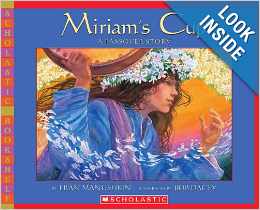
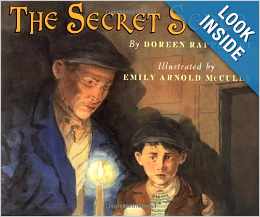
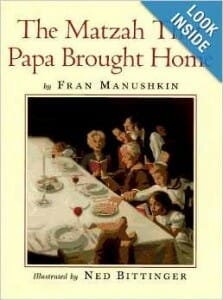
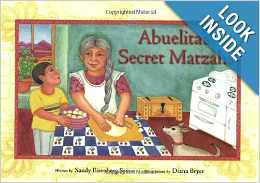
Leave a Reply
You must be logged in to post a comment.